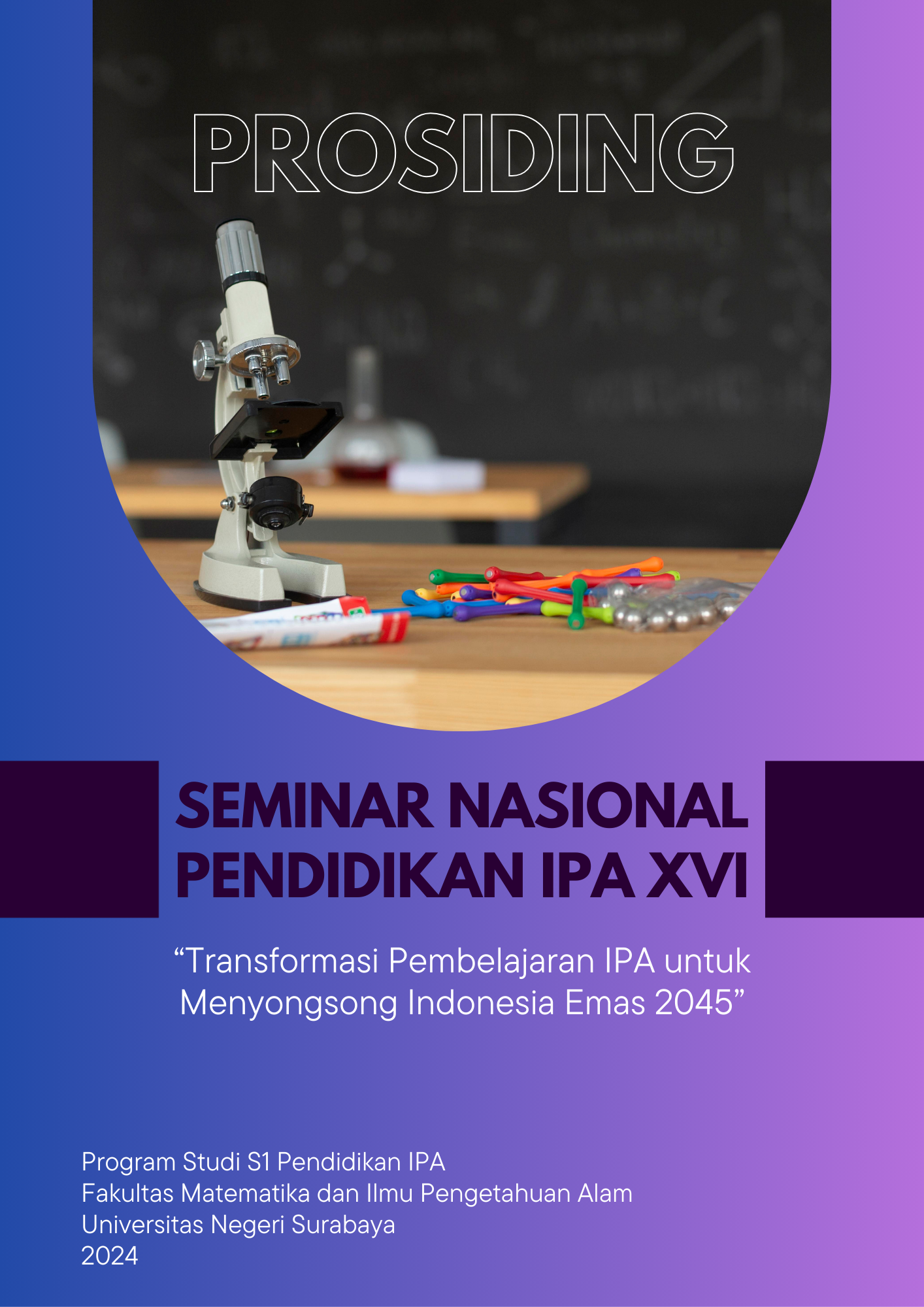PENDEKATAN LABIRIN UNTUK MENINGKATKAN HASIL BELAJAR KOGNITIF DAN MENDAPATKAN GAMBARAN MOTIVASI BELAJAR PESERTA DIDIK
Keywords:
Cognitive achievement, students' motivation, LABIRIN approachAbstract
The learning process in schools currently is still teacher-centered by applying a traditional approach. The learning carried out does not create exciting, interactive and unique learning. The way to improve students' cognitive learning outcomes was using the LABIRIN approach (exciting, interactive, unique-based learning). The aim of this research are (a) to get an increase in the cognitive learning outcomes of participants in vibration and wave material for class VIII students at SMPN 2 Pagedangan after being taught using the LABIRIN approach, (b) to get an idea of the difference in N-Gain in increasing cognitive learning outcomes between the experimental group and the control group , (c) get an overview of the differences in learning motivation between the experimental group and the control group after being given different treatments. This research used a quantitative method with a quasi-experimental design which was carried out in the experimental group VIII 1 and the control group VIII 3 in one of the junior high schools in Tangerang district in the even semester of 2023/2024. The instruments used are tests and questionnaires. The results of research data analysis show that; (a) The LABIRIN approach can improve the cognitive learning outcomes of class VIII students at SMP Negeri 2 Pagedangan on vibration and wave material, (b) The cognitive learning outcomes of students taught using the LABIRIN approach are higher than those of the group taught using the traditional approach. (c) Students who are taught using the LABIRIN approach have high learning motivation. Based on the results of data analysis calculations using the t test with a significance level of α= 5%, the values obtained are tcount=2.034 and tcount=1.998, meaning reject H0 and accept Ha. Based on the results of data analysis, there is a difference in the increase in cognitive learning outcomes of students after being taught using the LABIRIN approach compared to using a traditional approach
References
Abidin, Z. (2006). Motivasi Dalam Strategi Pembelajaran Dengan Pendekatan “ARCS.” https://publikasiilmiah.ums.ac.id/xmlui/bitstream/handle/11617/890/4.%20Zaenal%20Abidin.pdf?sequence=1&isAllowed=y
Amelia, T., & Rahmalia Natsir, S. (2023). Penerapan Model Joyfull Learning Berbasis Ice Breaking dalam Meningkatkan Hasil Belajar Matematika. Penuh Asa: Jurnal Mahasiswa PGSD, 1(3), 415–422. https://doi.org/10.35326/penuhasa.v8i4.3823
AMG Media. (2023). Metode pembelajaran Interaktif: Cara Efektif Belajar di Era Digital. Metode Pengajaran. https://www.amg.ac.id/metode-pembelajaran-interaktif/
Bistari Basuni Yusuf. (2018). Konsep Dan Indikator Pembelajaran Efektif. Jurnal Kajian Pembelajaran dan Keilmuan , 1(2), 13–20. https://jurnal.untan.ac.id/index.php/jurnalkpk/article/view/25082
Gita Lestari, D., & Irawati, H. (2020). Literature Review: Peningkatan Hasil Belajar Kognitif Dan Motivasi Siswa Pada Materi Biologi Melalui Model Pembelajaran Guided Inquiry. BIOMA, 2(2), 51–59. https://ojs.unsulbar.ac.id/index.php/bioma/article/view/861/481
Guntara, Y. (2020). Normalized Gain: Ukuran Keefektifan Treatment. Catatan Kuliah. https://doi.org/10.13140/RG.2.2.27603.40482
Hake, R. R. (1998). Interactive-engagement versus traditional methods: a six-thousand-student survey of mechanics test data for introductory physics courses. American Journal of Physics, 66(1), 64–74. https://doi.org/10.1119/1.18809
Hake, R. R. (2002). Relationship of Individual student normalized learning gains in mechanics with gender, high-school physics, and pretest scores on mathematics and spatial visualization. Physics Education Research Conference, 1–14. http://www.physics.indiana.edu/~hake
Hamdu, G., & Agustina, L. (2011). Pengaruh Motivasi Belajar Terhadap Prestasi Belajar IPA di Sekolah Dasar (Studi Kasus terhadap Siswa Kelas IV SDN Tarumanagara Kecamatan Tawang Kota Tasikmalaya). Dalam Jurnal Penelitian Pendidikan (Vol. 12, Nomor 1).
Hikmah Marisda, D. (2023). Efektivitas Pembelajaran Dengan Assesmen Berbasis Kahoot Terhadap Motivasi Belajar Fisika Peserta Didik. Jurnal Pendidikan dan Ilmu Fisika , 9, 314–318. https://scholar.google.com/scholar?hl=id&as_sdt=0%2C5&q=EFEKTIVITAS+PEMBELAJARAN+DENGAN+ASSESMEN+BERBASIS+KAHOOT+TERHADAP+MOTIVASI+BELAJAR+FISIKA+PESERTA+DIDIK&btnG=
Ibnu Adam, R., Rizal, A., Informatika, T., Ilmu Komputer, F., & Singaperbangsa Karawang, U. (2020). Pelatihan Penggunaan Laboratorium Virtual untuk Meningkatkan Kualitas Pemahaman Konsep Fisika Di SMA Negeri 6 Karawang. Jurnal Penelitian dan Pengabdian Kepada Masyarakat UNSIQ, 8(1), 95–98. https://ojs.unsiq.ac.id/index.php/ppkm/article/view/1008/1024
Kurniawati, W. (2022). Meningkatkan Hasil Belajar Siswa Kelas VIII SMP Negeri 19 Kota Bogor Melalui Penggunaan Media Simulasi Virtual PhET Pada Pelajaran Ipa Materi Getaran. Journal of Social Studies Arts and Humanities (JSSAH), 2(2), 130–136. https://doi.org/10.33751/jssah.v2i2.7139
Lindner, M. A., Schult, J., & Mayer, R. E. (2020). A multimedia effect for multiple-choice and constructed-response test items. Journal of Educational Psychology. https://doi.org/10.1037/edu0000646
Made Bagiarta. (2021). Penerapan PAIKEM untuk Meningkatkan Hasil Belajar IPA. Journal of Education Action Research, 5(2), 285–293. https://ejournal.undiksha.ac.id/index.php/JEAR/index
Muafiah, A., & Nasrah. (2020). Analisis Motivasi Belajar dan Hadil Belajar Daring Mahasiswa pada Masa Pandemik Covid-19. Jurnal Riset Pendidikan Dasar, 3(2), 207–213. http://journal.unismuh.ac.id/index.php/jrpd
Naimah, M. (2016). Pandangan dan Pendekatan Pembelajaran, dan Implementasinya dalam Pembelajaran Bahasa Arab. https://prosiding.arab-um.com/index.php/konasbara/article/viewFile/92/85
Nurrita, T. (2018). Pengembangan Media Pembelajaran untuk Meningkatkan Hasil Belajar Siswa (Vol. 03). https://pdfs.semanticscholar.org/9642/924d69e47d2aaaa01c9884a402c34a7bf13f.pdf
Oktiani, I. (2017). Kreativitas Guru dalam Meningkatkan Motivasi Belajar Peserta Didik. Jurnal Kependidikan, 5(2), 216–232. https://doi.org/10.24090/jk.v5i2.1939
Purwari, Y. (2020). Pendekatan Saintifik dengan Metode Gasing pada Pembelajaran Fisika. JPGI (Jurnal Penelitian Guru Indonesia), 5(1), 7–12. https://doi.org/10.29210/02507jpgi0005
Puspita Anggraeni, F., & Ginanjar, A. (2020). Efektivitas Model Pembelajaran E-Learning Dengan Media Kahoot Terhadap Kemampuan Analisis Peserta Didik Pada Mata Pelajaran IPS Kelas VII SMP Islam Al Azhar 29 Semarang. Sosiolium: Jurnal Pembelajaran IPS, 72–83. https://journal.unnes.ac.id/sju/sosiolium/article/view/37442
Rahayu, S., & Erman, D. (2017). Penerapan Pendekatan Saintifik dengan Media Simulasi PhET pada Materi Gelombang untuk Meningkatkan Pemahaman Konsep Siswa SMP. Pensa E-jurnal: Pendidikan Sains, 5(03), 253–256. https://ejournal.unesa.ac.id/index.php/pensa/article/view/20170/18468
S. A. Suharman, P. P. (2011). Penerapan Pendekatan PAKEM (Pembelajaran Aktif Kreatif Efektif dan Menyenangkan) untuk Meningkatkan Hasil Belajar Fisika Siswa Kelas X2 SMA Negeri 1 Pangkajene. JSPF, 7(2), 140–152. http://eprints.unm.ac.id/31477/
Sanjaya, W. (2006). Strategi Pembelajaran Berorientasi Standar Proses Pendidikan (1 ed.). Kencana Prenada Media Group.
Sugiyono. (2014a). Metode Penelitian Kuantitatif Kualitatif dan R&D. ALFABETA.
Sugiyono. (2014b). Statistika untuk Penelitian (Revisi terbaru). ALFABETA.
Sundayana, H. R. (2014). Statistika Penelitian Pendidikan. ALFABETA.
Utari Retno, & Madya Widyaiswara. (2011). TAKSONOMI BLOOM Apa dan Bagaimana Menggunakannya. https://www.academia.edu/download/36777006/766_1-Taksonomi_Bloom_-_Retno-ok-mima.pdf
Downloads
Published
How to Cite
Issue
Section
License
Copyright (c) 2025 Mega Susanty Manalu, Franky A.M. Lumbantobing, Murni

This work is licensed under a Creative Commons Attribution 4.0 International License.



